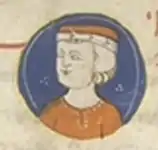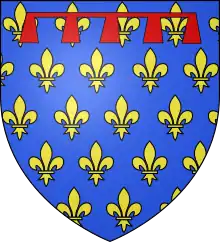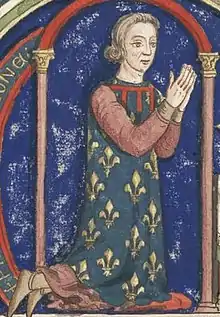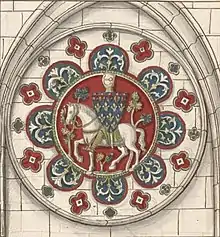Philip I, Count of Boulogne
Philip I of Boulogne (Philip Hurepel)[1] (1200–1235) was a French prince, Count of Clermont-en-Beauvaisis in his own right, and Count of Boulogne,[1] Mortain, Aumale, and Dammartin-en-Goële jure uxoris.
| Philip I | |
|---|---|
| jure uxoris Count of Boulogne Count of Clermont-en-Beauvaisis | |
 | |
| Born | Philippe Hurepel September 1200 |
| Died | 1235 (aged 33–34) |
| Spouse | Matilda II, Countess of Boulogne |
| Issue | Joan, Countess of Nevers, Lady de Châtillon-Montjay Alberic, Count of Clermont |
| House | Capet |
| Father | Philip II of France |
| Mother | Agnes of Merania |
Philip was born in September 1200, the son of Philip II of France[2] and his controversial third wife Agnes of Merania.[3] Illegitimacy shadowed his birth and career, but he was legitimated by Pope Innocent III.[4] He was associated with founding the Tour du Guet in Calais.[5] He is the first recorded person to bear a differenced version of the arms of France.[6]




Marriage
Philip was married in c. 1223 to Matilda II, Countess of Boulogne.[1] Philip, by right of his wife, became Count of Boulogne, Mortain, Aumale, and Dammartin-en-Goële. He revolted against his sister-in-law Blanche of Castile when his elder half-brother Louis VIII died in 1226.[7] When Philip died in 1235, Matilda continued to reign and was married to Afonso III of Portugal.
Matilda and Philip had:
- Alberic of Boulogne
- Joan of Boulogne married Gaucher de Châtillon in 1236.
Ancestry
| Ancestors of Philip I, Count of Boulogne | |||||||||||||||||||||||||||||||||||||||||||||||||||||||||||||||||||||||||||||||||||||||||||||||||||||||||||||||||||||||||||||||||||||||||||||||||||||||||||||||||||||||||||||||||||||||||||||||||||||||||||||||||||||||||||||||||||||||||||||||||||||||||||||||||||||||||||||||||||||||||
|---|---|---|---|---|---|---|---|---|---|---|---|---|---|---|---|---|---|---|---|---|---|---|---|---|---|---|---|---|---|---|---|---|---|---|---|---|---|---|---|---|---|---|---|---|---|---|---|---|---|---|---|---|---|---|---|---|---|---|---|---|---|---|---|---|---|---|---|---|---|---|---|---|---|---|---|---|---|---|---|---|---|---|---|---|---|---|---|---|---|---|---|---|---|---|---|---|---|---|---|---|---|---|---|---|---|---|---|---|---|---|---|---|---|---|---|---|---|---|---|---|---|---|---|---|---|---|---|---|---|---|---|---|---|---|---|---|---|---|---|---|---|---|---|---|---|---|---|---|---|---|---|---|---|---|---|---|---|---|---|---|---|---|---|---|---|---|---|---|---|---|---|---|---|---|---|---|---|---|---|---|---|---|---|---|---|---|---|---|---|---|---|---|---|---|---|---|---|---|---|---|---|---|---|---|---|---|---|---|---|---|---|---|---|---|---|---|---|---|---|---|---|---|---|---|---|---|---|---|---|---|---|---|---|---|---|---|---|---|---|---|---|---|---|---|---|---|---|---|---|---|---|---|---|---|---|---|---|---|---|---|---|---|---|---|---|---|---|---|---|---|---|---|---|---|---|---|---|---|---|---|---|
| |||||||||||||||||||||||||||||||||||||||||||||||||||||||||||||||||||||||||||||||||||||||||||||||||||||||||||||||||||||||||||||||||||||||||||||||||||||||||||||||||||||||||||||||||||||||||||||||||||||||||||||||||||||||||||||||||||||||||||||||||||||||||||||||||||||||||||||||||||||||||
References
- Wood 1966, p. 9.
- Baldwin 1991, p. 357.
- Baldwin 1991, p. 86.
- Bradbury 2015, p. 185.
- Base Mérimée: PA00108248, Ministère français de la Culture. (in French)
- Neubecker 1976, p. 98
- Barber 1992, p. 266.
Sources
- Baldwin, John (1991). The Government of Philip Augustus. University of California Press.
- Barber, Malcolm (1992). The Two Cities: Medieval Europe 1050–1320. Routledge.
- Bradbury, Jim (2015). Philip Augustus: King of France 1180-1223. Taylor & Francis.
- Neubecker, Ottfried (1976). Le Grand livre de l'héraldique [Heraldry: sources, symbols, and meaning]. Translated by Harmignies, Roger. New York: McGraw-Hill. ISBN 9780070463080.
- Wood, Charles T. (1966). The French Apanages and the Capetian Monarchy: 1224-1328. Harvard University Press.